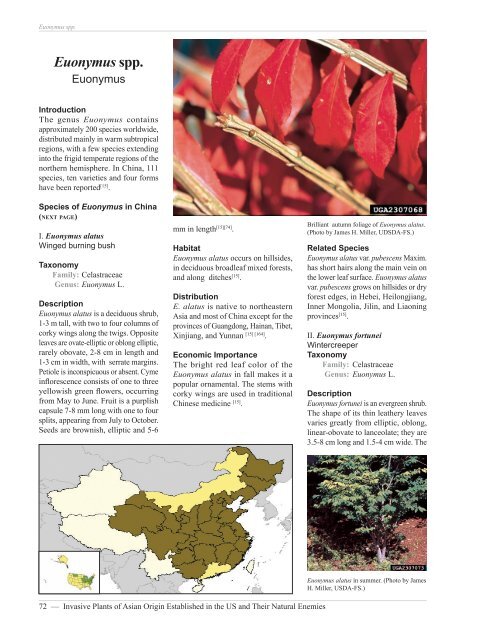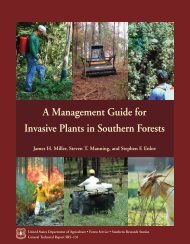Euonymus spp.
Euonymus spp.
Euonymus spp.
Create successful ePaper yourself
Turn your PDF publications into a flip-book with our unique Google optimized e-Paper software.
<strong>Euonymus</strong> <strong>spp</strong>.<br />
<strong>Euonymus</strong> <strong>spp</strong>.<br />
<strong>Euonymus</strong><br />
Introduction<br />
The genus <strong>Euonymus</strong> contains<br />
approximately 200 species worldwide,<br />
distributed mainly in warm subtropical<br />
regions, with a few species extending<br />
into the frigid temperate regions of the<br />
northern hemisphere. In China, 111<br />
species, ten varieties and four forms<br />
have been reported [15] .<br />
Species of <strong>Euonymus</strong> in China<br />
(NEXT PAGE)<br />
I. <strong>Euonymus</strong> alatus<br />
Winged burning bush<br />
Taxonomy<br />
Family: Celastraceae<br />
Genus: <strong>Euonymus</strong> L.<br />
Description<br />
<strong>Euonymus</strong> alatus is a deciduous shrub,<br />
1-3 m tall, with two to four columns of<br />
corky wings along the twigs. Opposite<br />
leaves are ovate-elliptic or oblong elliptic,<br />
rarely obovate, 2-8 cm in length and<br />
1-3 cm in width, with serrate margins.<br />
Petiole is inconspicuous or absent. Cyme<br />
inflorescence consists of one to three<br />
yellowish green flowers, occurring<br />
from May to June. Fruit is a purplish<br />
capsule 7-8 mm long with one to four<br />
splits, appearing from July to October.<br />
Seeds are brownish, elliptic and 5-6<br />
mm in length [15][74] .<br />
Habitat<br />
<strong>Euonymus</strong> alatus occurs on hillsides,<br />
in deciduous broadleaf mixed forests,<br />
and along ditches [15] .<br />
Distribution<br />
E. alatus is native to northeastern<br />
Asia and most of China except for the<br />
provinces of Guangdong, Hainan, Tibet,<br />
Xinjiang, and Yunnan [15] [164] .<br />
Economic Importance<br />
The bright red leaf color of the<br />
<strong>Euonymus</strong> alatus in fall makes it a<br />
popular ornamental. The stems with<br />
corky wings are used in traditional<br />
Chinese medicine [15] .<br />
72 — Invasive Plants of Asian Origin Established in the US and Their Natural Enemies<br />
Brilliant autumn foliage of <strong>Euonymus</strong> alatus.<br />
(Photo by James H. Miller, UDSDA-FS.)<br />
Related Species<br />
<strong>Euonymus</strong> alatus var. pubescens Maxim.<br />
has short hairs along the main vein on<br />
the lower leaf surface. <strong>Euonymus</strong> alatus<br />
var. pubescens grows on hillsides or dry<br />
forest edges, in Hebei, Heilongjiang,<br />
Inner Mongolia, Jilin, and Liaoning<br />
provinces [15] .<br />
II. <strong>Euonymus</strong> fortunei<br />
Wintercreeper<br />
Taxonomy<br />
Family: Celastraceae<br />
Genus: <strong>Euonymus</strong> L.<br />
Description<br />
<strong>Euonymus</strong> fortunei is an evergreen shrub.<br />
The shape of its thin leathery leaves<br />
varies greatly from elliptic, oblong,<br />
linear-obovate to lanceolate; they are<br />
3.5-8 cm long and 1.5-4 cm wide. The<br />
<strong>Euonymus</strong> alatus in summer. (Photo by James<br />
H. Miller, USDA-FS.)
whitish green flowers bloom in June<br />
and occur in a cymose inflorescence.<br />
The fruit of <strong>Euonymus</strong> fortunei is a<br />
pinkish, subglobular capsule 6-12 mm<br />
in diameter. The seed is brown, oblong,<br />
and ripens in October [2] .<br />
Habitat<br />
<strong>Euonymus</strong> fortunei occurs on hillsides,<br />
in forests, forest margins, and thickets<br />
along riverbanks [15] .<br />
Distribution<br />
Euonymous fortunei occurs in Anhui,<br />
Fujian [36] , Gansu [70] , Guangxi [51] ,<br />
Guizhou [97] , Henan [25] , Hubei, Hunan,<br />
Jiangxi, Jiangsu, Shaanxi, Sichuan,<br />
Yunnan, and Zhejiang provinces [15] .<br />
Species of <strong>Euonymus</strong> in China<br />
Economic Importance<br />
Stems and leaves are medicinally<br />
useful [74] .<br />
<strong>Euonymus</strong> <strong>spp</strong>.<br />
Natural Enemies of <strong>Euonymus</strong><br />
Ten species of fungi and 28 arthropods<br />
have been recorded in association with<br />
the genus <strong>Euonymus</strong>.<br />
Scientific Name Scientific Name Scientific Name<br />
E. acanthocarpus Franch. E. actinocarpus Loes. E. aculeatus Hemsl<br />
E. aculeolus C. Y. Cheng ex J. S. Ma E. alatus (Thunb.) Sieb E. amygdalifolius Franch.<br />
E. angustatus Sprague E. austro-tibetanus Y. R. Li E. bockii Loes.<br />
E. carnosus Hemsl. E. centidens Lévl. E. chengii J. S. Ma<br />
E. chenmoui Cheng E. chloranthoides Yang E. chuii Hand.-Mazz.<br />
E. cinereus Laws E. clivicolus W. W. Smith E. contractus Sprague<br />
E. corntus Hemsl. E. crenatus C. H. Wang E. dielsianus Loes.<br />
E. distichus Lévl. E. dolichopus Merr. ex J. S. Ma E. echinatus Wall. ex Roxb<br />
E. ellipticus (C. H. Wang) C. Y. Cheng E. euscaphis Hand.-Mazz. E. fertilis (Loes.) C. Y. Cheng ex C. Y. Cheng<br />
E. ficoides C. Y. Cheng ex J. S. Ma E. fimbriatus Wall. ex Roxb. E. fortunei (Turcz.) Hand.-Mazz.<br />
E. frigidus Wall. ex Roxb. E. gibber Hance E. giraldii Loes.<br />
E. gracillimus Hemsl. E. grandiflorus Wall. E. hainanensis Chun et How<br />
E. hamiltonianus Wall. ex Roxb. E. hederaceus Champ. ex Benth. E. hemsleyanus Loes.<br />
E. hui J. S. Ma E. hukuangensis C. Y. Cheng ex J. S. Ma E. hystrix W. W. Smith<br />
E. japonicus Thunb. E. jinfoshanensis Z. M. Gu E. jinggangshanensis M. X. Nie<br />
E. jinyangensis C. Y. Chang E. Kengmaensis C. Y. Cheng ex J. S. Ma E. kiautschovicus Loes.<br />
E. kwangtungensis C. Y. Chen E. lawsonii C. B. Clarke ex Prain E. laxicymosus C. Y. Cheng ex J. S. Ma<br />
E. laxiflorus Charmp. ex Benth E. leclerei Lévl. E. lichiangensis W. W. Smith<br />
E. linearifolius Franch. E. maackii Rupr. E. macropterus Rupr.<br />
E. maximowiczianus (Prokh.) Varosh E. mengtseanus (Loes.) Sprague E. microcarpus (Oliv.) Sprague<br />
E. mitratus Pierre E. morrisonensis Kanehira et Sasaki E. myrianthus Hemsl.<br />
E. nanoides Loes. E. nanus Bieb E. nitidus Benth.<br />
E. oblongifolius Loes. et Rehd. E. omeiensis Fang E. oxyphyllus Miq.<br />
E. pallidifolius Hayata E. parasimilis C. Y. Cheng ex J. S. Ma E. paravagans Z. M. Gu<br />
E. pashanensis S. Z. Qu et Y. H. He E. pendulus Wall. ex Roxb. E. perbellus C. Y. Chang<br />
E. percoriaceus C. Y. Wu ex J. S. Ma E. phellomanus Loes. E. porphyreus Loes.<br />
E. potingensis Chun et How ex J. S. Ma E. przwalskii Maxim E. pseudo-sootepensis Y. R. Li et S. G. Wu<br />
E. rehderianus Loes. E. rostratus W. W. Smith E. sanguineus Loes.<br />
E. saxicolus Loes. et Rehd. E. scandens Graham E. schensianus Maxim.<br />
E. semenovii Regel E. spraguei Hayata E. subsessilis Sprague<br />
E. subtrinervis Rehd. E. szechuanensis C. H. Wang E. tashiroi Maxim.<br />
E. tengyuehensts W. W. Smith E. theacolus C. Y. Cheng E. theifoius Wall.<br />
E. tibeticus W. W. Smith E. tingens Wall. E. tonkinenis Loes.<br />
E. trichocarpus Hayata E. vagans Wall. ex Roxb. E. vasanoides C. Y. Cheng ex J. S. Ma<br />
E. venosus Hemsi E. verrucosoides Loes. E. verrucosus Scop.<br />
E. viburnoides Prain E. wensiensis J. W. Ren et D. S. Yao E. wilsonii Sprague<br />
E. wui J. S. Ma E. xylocarpus C. Y. Cheng et Z. M. Gu E. yunnanensis Franch.<br />
Invasive Plants of Asian Origin Established in the US and Their Natural Enemies — 73
<strong>Euonymus</strong> <strong>spp</strong>.<br />
Fungi<br />
Phylum Family Species H. R. Ref.<br />
Anamorphic Acantharia Fusicladium euonymi-japonici Hori mo 23<br />
Anamorphic Ascomycetes<br />
Coleophoma cylindrospora (Desm.) Höhn. oo 23 †<br />
Sphaeropsis euonymi Gabotto mo 23<br />
Anamorphic Broomella Pestalotia planimi Vize mo 23<br />
Anamorphic Erysiphe Oidium euonymi-japonici (Arcang.) Sacc. mo 23<br />
Anamorphic Guignardia Phyllosticta bolleana Sacc. oo 23<br />
Anamorphic Leptosphaeria Phoma subnervisequa Desm. mo 23<br />
Anamorphic Mycosphaerella<br />
Cercosporella euonymi Erikss. oo 23<br />
Pseudocercospora destructiva (Ravenel) Y.L. Guo & X.J. Liu<br />
74 — Invasive Plants of Asian Origin Established in the US and Their Natural Enemies<br />
mo 23 ‡<br />
oo 110<br />
Anamorphic Pyrenopeziza Cylindrosporium frigidum (Sacc.) Vassiljevsky mo 23<br />
† Recorded as Macrophoma cylindrospora (Desm.) Berl. et Vogl.<br />
‡ Recorded as Cercospora destructiva Rav.<br />
Arthropods<br />
Order Family Species H.P.R. Ref.<br />
Coleoptera Cerambycidae Acalolepta sublusca (Thomson) po 124<br />
Aphididae Aphis clerodendri Matsumura po 100<br />
Ceroplastes japonicus Green po 151<br />
Ceroplastes rubens Maskell po 151<br />
Coccidae<br />
Chloropulvinaria aurantii (Cockerell)<br />
p<br />
po<br />
85<br />
151<br />
p 65<br />
Chloropulvinaria floccifera (Westwood)<br />
p 85<br />
Homoptera<br />
Aonidiella aurantii (Maskell)<br />
po<br />
p<br />
151<br />
85<br />
Chrysomphalus dictyospermi (Morgan) p 85<br />
Lepidosaphes corni (Takahashi) p 85<br />
Diaspididae<br />
I<br />
Lepidosaphes gloverii (Packard)<br />
p<br />
p<br />
65<br />
140<br />
Parlatoria camelliae Comstock p 85<br />
Unaspis euonymi (Comstock) p 131<br />
Margarodidae Icerya purchasi Maskell p 140<br />
p 65<br />
Abraxas suspecta Warren<br />
p 138<br />
Geometridae<br />
Lepidoptera<br />
II<br />
p 158<br />
Amraica superans (Butler) p 65<br />
Buzura recursaria superans Butler<br />
p<br />
po<br />
85<br />
138<br />
Buzura thibetaria Oberthür p 158<br />
Abraxus suspecta Warren p 85<br />
Phthonosema invenustaria Leech<br />
p<br />
p<br />
85<br />
138<br />
Xandrames dholaria sericea Butler m 158<br />
Tortricidae Homona magnanima Diakonoff<br />
p<br />
p<br />
65<br />
158<br />
Yponomeuta anatolicus Stringer oo 114<br />
Yponomeuta bipunctellus Matsumura m 114<br />
Yponomeuta griseatus Moriuti mo 114<br />
Yponomeutidae<br />
Yponomeuta kanaiellus Matsumura<br />
Yponomeuta pedallus (Linnaeus)<br />
mo<br />
p<br />
114<br />
114<br />
Yponomeuta polystigmellus Felder et Felder<br />
p<br />
m<br />
85<br />
114<br />
Yponomeuta tokyonellus Matsumura m 114<br />
* For <strong>Euonymus</strong> alatus only, <strong>Euonymus</strong> fortunei is not included.<br />
I Recorded as Insulaspis corni (Takahashi)<br />
II Recorded as Calospilos suspecta Warren

















